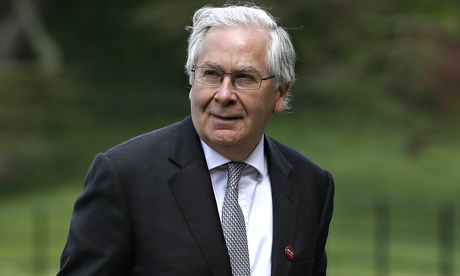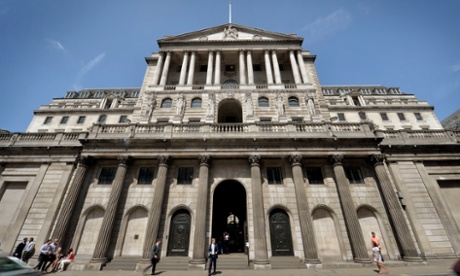It was 1 October 2008. Three people had assembled inside the Bank of England. They were the then governor of the Bank, Mervyn King, and two senior members of the Bank’s governing court, Sir John Parker and Amelia Fawcett. Their task was simple: to find a way of providing financial support to Fox, the code name for HBOS. Britain’s biggest mortgage lender was in so much trouble that without help from Threadneedle Street it would default that night.
The meetings of these three, and others who sat on a specially created transactions committee (Transco), took place during the financial crisis that culminated in the taxpayer bailouts of not just HBOS but also Lloyds TSB and Royal Bank of Scotland.
It was the biggest test of the Bank’s mettle in modern times and a series of hundreds of pages of documents released on Wednesday lift the lid for the first time on how officials coped.
Using the code name Lark for Lloyds TSB, the minutes of that meeting of Transco warned: “It was noted that the Bank’s exposure to Fox and Lark was likely to be around £180bn … this was very large.”
Transco – set up in November 2007 after Northern Rock became the first major high street lender to face a bank run in almost 150 years – only met 11 times, but seven of those meetings took place in the fortnight before 13 October 2008, the day the government outlined a detailed bailout of the banking system.
Minutes of its emergency meetings are released alongside those from the court of the Bank of England, the oversight body of the central bank – four years after being requested by the Treasury select committee as part of its efforts to get to the bottom of the causes of the £65bn bank bailouts.
The first signs of trouble in the financial markets had emerged on 9 August 2007, when there were concerns about the health of hedge funds which had been dabbling in US subprime mortgages. Up until that point the Bank was content to be an institution that focused on setting interest rates to hit the government’s inflation target. It had no wish to have more powers to police the City and continued with that approach long after Northern Rock in September 2007 became the first major high street bank to suffer a bank run since Overend, Gurney & Co in the 1860s.
The minutes of the court meeting on 12 September outlined general discussions about the state of the markets and the strength of the tripartite system of regulation which linked the Bank with the Treasury and the Financial Services Authority, the City regulator at the time. But on the following day, 13 September, the members were called to an emergency meeting to back an emergency lifeline for the troubled former building society.
At that point the Bank regarded the problem as one of liquidity – a lack of cash flow – rather than the risk of insolvency. Northern Rock was eventually nationalised in February 2008.
The Northern Rock crisis raised concerns about what the Bank needed to do to help UK financial institutions. There was enormous pressure on King, orchestrated by the high lenders, to step in and pump cash into the system. King’s initial view, reflected in the minutes from September 2007, was that this rewarded banks for bad behaviour.
By October 2008 – days after the bank bailouts – King was defending the Bank against accusations it was out of touch with market practice.
“It had been suggested that the Bank needed more staff with practical banking and markets experience,” the minutes said. “It was stressed that such a view was misplaced. What had been demonstrated over the recent period was that the most important role of a central bank was policymaking and it needed to have the right expertise to do that.”
The minutes show there was an uneasy calm in the late spring of 2008 following the nationalisation of Northern Rock and the rescue of the US investment bank Bear Stearns. Although it later emerged that the economy was already in recession, the Bank’s concern was then about the need to raise interest rates as oil prices headed to almost $150 per barrel, potentially stoking inflation. The minutes later recorded that some members of the rate-setting monetary policy committee regretted their decisions.
All the time, however, pressures on the financial system were building. The first mention of the US bank Lehman Brothers was in June 2008 when the court was told it “had been the subject of rumour and speculation over a few days, which fortunately had been so far contained”.
The court met on 10 September 10 2008 when Lehman reported its results and, in an accurate prediction of what was to come, the markets were expected to remain tense. Lehman was to collapse on 15 September 2008. “It agreed that the position remained very fragile, perhaps more so than indicated in the paper [presented to the court],” the minutes said.
Until the Lehman collapse the court had been discussing the situation on a bank-by-bank basis. During March banks had raised fresh capital, some with greater ease than others.
The minutes from September 2008 said there was now concern “that were few institutions that could act as a potential godparent for an institution in difficulty”. Lloyds TSB was to rescue HBOS in the days after Lehman collapsed but after that few such rescues were possible.
The October 2008 minutes went further: “There had been an initial belief that resolving individual institutions on a case-by-case basis was workable. But that had not proved to be the case as concerns spread across the financial system. It was explained that the Bank had sent a paper to the government to outline a possible plan to recapitalise the banking system. For some time it had been apparent that only a complete system-wide plan could resolve the ongoing problems in the banking system.”
The minutes of late autumn 2008 expressed a sense of relief that the banking system had been saved from collapse. But King and his colleagues showed concern that the impact of the meltdown in the banking system would affect the flow of credit to households and business and lead to a deep recession. They sought to alleviate the pain, first by cutting interest rates and then by pumping money into the economy by acquiring UK gilts, now better known as quantitative easing, or QE. “In contrast to much of the post-war period when the need had been invariably to reduce the supply of money to bring inflation down, the problem was now a need to increase the money supply and nominal spending. The APF provided a framework to do that,” the minutes said.
A member of the court asked whether QE would put the creditworthiness of the UK government at risk. The Bank made its view clear. “In response, it was suggested that much of the public commentary about the creditworthiness of the UK government was ill-informed. There was no doubt that the fiscal deficit would rise sharply … that was the inevitable price of dealing with the financial crisis … overall, it was not thought that the scale of the increase in public debt envisaged in the UK would threaten the ability of a democratic government to finance its debt, though there could, of course, be no guarantee of that.”












